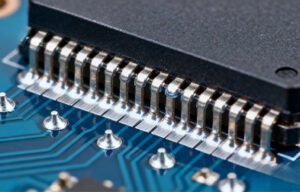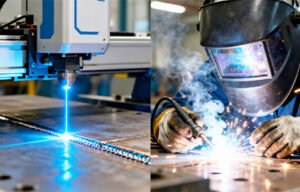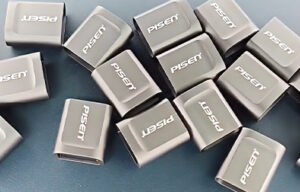How to Weld Thin Metal Without Distortion?
Introduction
Welding thin metal sheets has always been a technical challenge for manufacturers across industries such as electronics, medical devices, and precision instruments. A frequent concern is how to weld thin metal without causing distortion or burn-through. Traditional welding techniques often fall short due to high heat input and low controllability.
Fortunately, laser welding technology provides a modern, efficient, and distortion-free solution. In this article, we explore how laser welding works for thin metals and why it is the optimal choice for global manufacturers.
Challenges in Welding Thin Metal
Welding metal with a thickness under 1.5 mm—especially stainless steel, aluminum, or copper—presents several challenges:
Heat sensitivity: Thin metals easily warp when exposed to concentrated heat.
Low tolerance for burn-through: Even slight overexposure can melt or puncture the material.
Dimensional accuracy requirements: Industries like electronics and medical need micron-level precision.
Inconsistent weld quality: Manual and arc-based methods often produce variable results.
These factors increase scrap rates, lower productivity, and cause higher post-processing costs.
Why Traditional Welding Causes Distortion
Traditional welding methods, such as TIG (Tungsten Inert Gas) or MIG (Metal Inert Gas), rely on generating a molten pool through high heat input. This can lead to:
Excessive thermal expansion and contraction, resulting in warping.
Lack of control over heat-affected zones, especially at sheet edges.
Difficulty in maintaining uniform weld seams, due to operator dependency.
When the metal is thin, there’s little room for thermal error. Even minor overheating can lead to unacceptable deformations or joint weaknesses.
Laser Welding: The Game-Changing Technology
Laser welding is a high-precision process that uses a focused laser beam to melt and join metals. It offers:
Minimal heat input
Extremely narrow weld seams
High-speed operation
Precision control over depth and width
With fiber laser welding, even metals as thin as 0.2 mm can be joined seamlessly without distortion. This is why laser welding is becoming the go-to solution for manufacturers aiming to improve efficiency and quality.
How Laser Welding Prevents Deformation
Laser welding avoids distortion through several unique characteristics:
1. Low Heat Input
The energy is focused into a small area with short dwell time, which significantly reduces the size of the heat-affected zone.
2. Deep Penetration, Narrow Seam
The weld depth-to-width ratio is higher than other methods, meaning the heat is concentrated deep rather than spreading laterally.
3. Fast Welding Speed
Rapid welding limits heat buildup, helping preserve the original geometry of thin components.
4. Precision Beam Control
Laser systems allow micrometer-level control of energy, perfect for welding ultra-thin parts.
Advantages of Laser Welding for Thin Metals
Here are key benefits when using laser welding for thin sheet metal:
No warping or deformation
Minimal or no post-processing
High repeatability and consistency
Non-contact process avoids mechanical stress
Suitable for high-volume automation
Clean and aesthetic welds without discoloration
These advantages make laser welding ideal for industries with demanding quality standards.
Typical Applications for Laser Welding Thin Sheets
Laser welding is widely used in:
Medical instruments – stainless steel tubing, needle tips
Electronics – sensor housings, battery tabs
Jewelry & watches – delicate frame and chain welding
Automotive components – thin aluminum brackets, sensors
Aerospace – foil welding, battery enclosures
Battery & energy – lithium battery tabs, connectors
Recommended Laser Welding Machines for Thin Metal
When welding thin materials, the following types of laser welding machines are recommended:
1. Fiber Laser Welding Machines
Excellent beam quality
Low thermal distortion
Available in 1000W to 3000W power ranges
2. Galvo Laser Welding Systems
High-speed scanning
Ideal for micro-welding and small parts
3. Closed Cabinet Laser Welders
Safer for high-precision automated jobs
Protects workpieces from contamination
When selecting a machine, ensure it supports low-power stable modes and has real-time beam monitoring features.
Best Practices in Thin Metal Laser Welding
To achieve optimal results:
Use pulse or modulated continuous wave (CW) laser modes
Select proper shielding gas (e.g., Argon for stainless steel)
Fix and clamp the thin sheets properly
Ensure precise focus alignment
Use real-time monitoring systems for quality assurance
A well-calibrated setup greatly reduces the risk of heat deformation and ensures consistent weld quality.
Case Studies: Success in Thin Metal Welding
Case 1: Precision Welding of 0.3mm Stainless Steel Tubes
Industry: Medical
Result: Zero deformation, high tensile strength, no rework needed
Case 2: Aluminum Thin Sheet Welding in Electric Vehicles
Industry: EV Battery Manufacturing
Result: 45% cycle time reduction, distortion-free joints
Case 3: Watch Frame Micro Welding
Industry: Luxury Accessories
Result: Seamless appearance, no polishing required
These examples prove laser welding’s performance in real-world, high-precision thin metal welding scenarios.
Conclusion: Achieve High-Precision Results Without Distortion
If your business involves welding thin sheet metals, especially in sensitive or high-specification industries, laser welding is the most effective solution available today. It solves the core problem of deformation while improving productivity and reducing post-processing costs.
By investing in the right laser welding machine, you ensure better control, lower energy usage, and higher quality—without compromise.
Explore JOYLASER’s range of precision laser welding solutions tailored for thin metals, and contact our team to get expert support.
111-1024x458.png)


